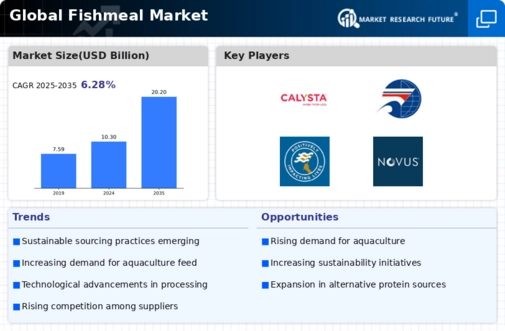Players of the market focus on the growing need for premium feed additives like a fishmeal as meat and dairy products become more industrialized to stimulate reproduction, boost metabolism, stop disease outbreaks, etc. The rise in chronic diseases is connected to the consumption of heavy metals like mercury, lead, cadmium, etc., that are found in conventionally-cultured seafood. Thus, major market developments are trying to solve these problems to capture a bigger share of the fishmeal market.
According to the market competitive landscape, the players are focusing on producing fishmeal products that are high in nutrition. Most fishmeal industry products are either produced from by-products of the fish processing industry or are derived from small, bony fish that are unfit for human consumption. As a result, animal feed made from fishmeal is cost-effective due to the valorization of byproducts. The demand for the product is therefore driven by the improvement of animal feed made possible by fishmeal. Fishmeal industry products have a high energy content per unit weight and are a highly digested feed element.
The ingredient is a great source of vitamins, minerals, oils (lipids), protein, and minimal carbohydrates. Major market players include FMC Corporation (US), Empresas, Copec S.A. (Chile), and Croda International Plc. (UK), Omega Protein Corporation (US), Calysta Inc. (U.S.), Biomega AS (Norway), Austevoll Seafood ASA (Norway), Pioneer Fishing (Pty) Ltd. (South Africa), Aker Biomarine Antarctic AS (Norway), Oceana Group Limited (South Africa), and Novus International Inc. (US).
The biorefining experts at biomega enabled them to create and patent their own patented continuous enzymatic hydrolysis process technology. The ideal processing conditions are necessary to optimize product attributes. As a result, it created and patent several reactors tailored especially for particular applications. Salmon, chicken, and turkey pet food and meal ingredients are currently produced using the method. In April 2021, the international manufacturer of fish oil and fishmeal, Biomega AS, will expand its business by funding a biorefinery in Denmark.
The company wants to strengthen its position in the fishmeal industry by promoting the development of products derived from salmon with the help of this facility's expansion.
Also, innovative process solutions are provided by Organic Technologies to the custom chemical manufacturing sector. It is based in east central Ohio and concentrates on toll production, specialized olefins, and fine chemical intermediates. Its goods, including our certified sustainable AlaskOmega Omega-3 product line, are also used in taste, functional food, and nutraceutical markets. Two additional DHA omega-3 concentrates were added to organic Technologies' existing product line in October 2019 and were positioned as alternatives to tuna oil.
Recent News:
In July 2023, an experimental endeavor was initiated by the Kerala University of Fisheries and Ocean Studies (Kufos) to convert organic refuse into fish meal. Using black soldier fly larvae, the initiative intends to produce the protein required for fish feed from organic waste. For this purpose, organic waste will be separated at the source. The initiative is currently being executed in partnership with Amala Eco Clean Private Limited, an Alappuzha-based organization specializing in the management of organic waste. Using black soldier fly larvae, the initiative intends to produce the protein required for fish feed from organic waste.
September 2022: Scoular, one of the largest suppliers of feed ingredients in the world, introduced the Encompass brand of fishmeal in September 2022 as part of its aggressive expansion into the aquafeed industry. The demand for fishmeal has increased due to the expansion of the aquaculture and pet food sectors. This product provides valuable omega-3 fatty acids and easily digestible protein, sourced from a diverse range of species, characteristics, and countries.
Scoular provides a global selection of marine proteins sourced from over 40 countries throughout the year, encompassing a substantial inventory of sustainable products. For decades, Scoular has been involved in fishmeal on a global scale. The company intends to pursue aggressive global expansion, has a significant presence in Mexico, and is the largest importer of fishmeal in the United States. Investing $12 million with two partners in a fishmeal processing facility in Oregon that serves pet food and aquaculture manufacturers with locally sourced fish processing waste.
Scoular's initial investment in fishmeal production within the United States is anticipated to commence operations at the facility in 2022.
















Leave a Comment